The HP EX920 M.2 SSD Review: Finding the Mainstream Sweet Spot
by Billy Tallis on July 9, 2018 9:00 AM ESTAnandTech Storage Bench - The Destroyer
The Destroyer is an extremely long test replicating the access patterns of very IO-intensive desktop usage. A detailed breakdown can be found in this article. Like real-world usage, the drives do get the occasional break that allows for some background garbage collection and flushing caches, but those idle times are limited to 25ms so that it doesn't take all week to run the test. These AnandTech Storage Bench (ATSB) tests do not involve running the actual applications that generated the workloads, so the scores are relatively insensitive to changes in CPU performance and RAM from our new testbed, but the jump to a newer version of Windows and the newer storage drivers can have an impact.
We quantify performance on this test by reporting the drive's average data throughput, the average latency of the I/O operations, and the total energy used by the drive over the course of the test.
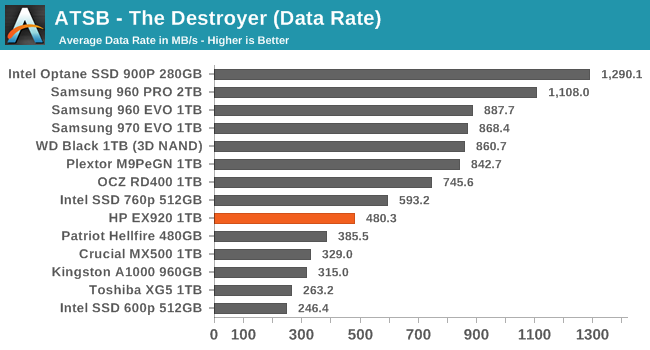
The average data rate from the 1TB HP EX920 on The Destroyer is a bit disappointing, falling below the lower-capacity Intel 760p and only a little over half as fast as current 1TB high-end NVMe SSDs. The EX920 is still substantially faster than SATA SSDs or low-end NVMe SSDs like the Phison E8-based Kingston A1000, but the EX920 is definitely not in the same league as Samsung's drives or the current WD Black.
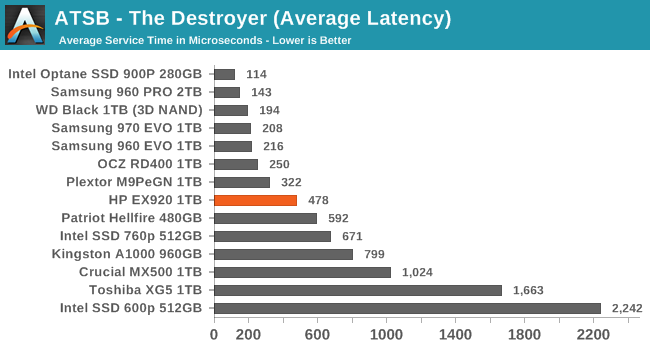
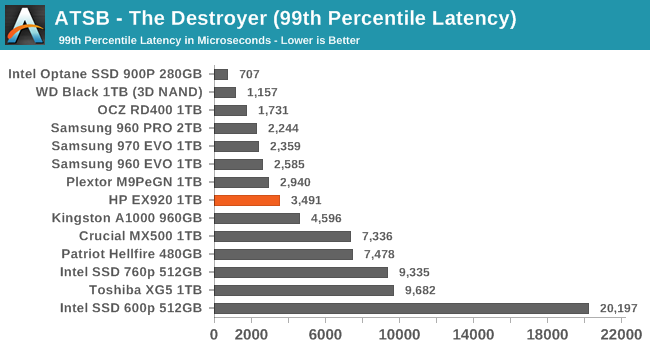
The average and 99th percentile latency scores from the HP EX920 cast the drive in a slightly better light than the average data rate did, but it is still falling short of the high-end NVMe drives. The EX920 scores better than the smaller Intel 760p on these two metrics, even though the Intel drive delivered a higher average data rate.
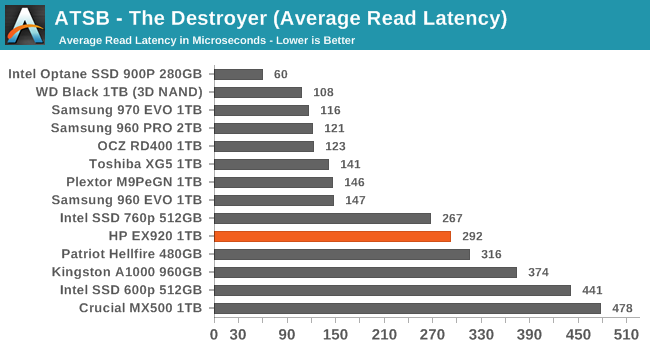

The HP EX920's average read latency is about twice as high as the high-end NVMe SSDs. The average write latency of the EX920 is also worse than the Samsung drives and WD Black by about the same factor, but the boundary for the top tier of drives is not as sharp since the Plextor M9Pe and the aging Toshiba OCZ RD400 are also lagging behind some.
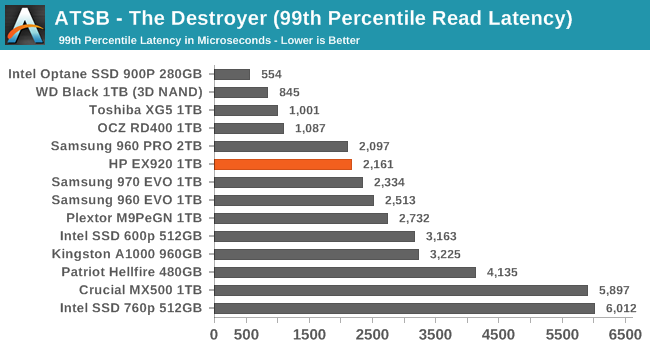
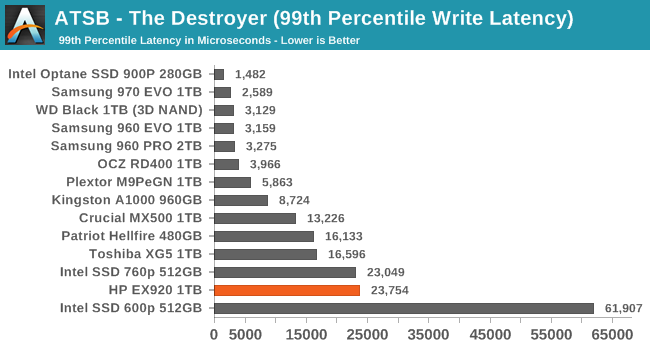
The 99th percentile read latency of the HP EX920 is decent, though it could also be said that this is simply a matter of Samsung's drives being uncharacteristically unimpressive while the WD Black sets a high standard. The 99th percentile write latency of the EX920 is clearly a problem, with more than 40% higher latency than any drive in this bunch that isn't using a Silicon Motion controller. The EX920 and Intel 760p fare much better than the previous generation Intel 600p thanks to improvements to both the flash and the controller, but it is clear that Silicon Motion still needs to work of their QoS.
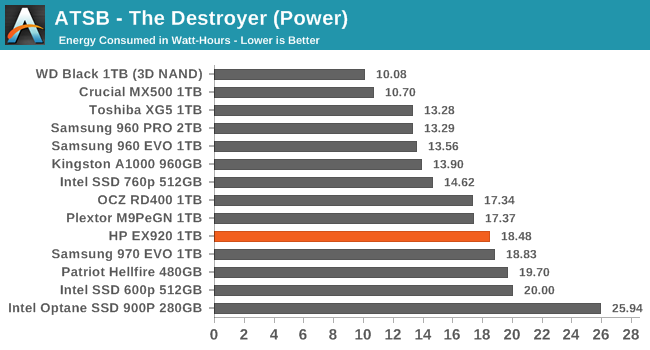
The energy usage of the HP EX920 when running The Destroyer is a bit on the high side by M.2 NVMe SSD standards, but it doesn't stand out from other power-hungry drives including the Samsung 970 EVO. Unlike the 970 EVO, the EX920 doesn't justify its high power consumption with high performance, though even the 970 EVO's power consumption is hard to excuse when the WD Black offers the same performance for a little over half of the energy usage. NVMe power efficiency is still a work in progress for the industry as a whole.










32 Comments
View All Comments
DigitalFreak - Monday, July 9, 2018 - link
Too bad NVMe drives still have a price premium over SATA, but at least we're starting to get good performing drives without the ridiculous Samsung markup.bubblyboo - Tuesday, July 10, 2018 - link
I mean I just got a 512GB 970 Pro for <$200 but sure Samsung has a "ridiculous markup".grahad - Tuesday, July 10, 2018 - link
Sales don't really count. It's 229.99 on Amazon and Newegg at the moment.bubblyboo - Tuesday, July 10, 2018 - link
That's still not much since it's just about the only consumer 3D MLC NVME drive.Hectandan - Thursday, July 12, 2018 - link
There are still few SSDs besides Samsung with consistent performance under heavy workload, and I don't know why one needs NVMe at all if not for some kind of workload.shabby - Monday, July 9, 2018 - link
Can you guys start separating tests based on ssd sizes? Seeing a 1tb ssd benched against one half its size or even a quarter somewhat isn't fair.Billy Tallis - Monday, July 9, 2018 - link
The drives in this review that aren't 1TB are either representing controller+NAND combinations that I don't have a 1TB drive for, or are there to show how the same controller+NAND combination as the drive being reviewed scales with capacity.milkod2001 - Monday, July 9, 2018 - link
Would be nice if prices came down so this would be more popular and they would sell more. I mean 1TB m2 SSD under $100 would be nice. I doesn't cost them more than 20 bucks to make one anyway.mkaibear - Monday, July 9, 2018 - link
What's your source on that bill of materials? It sounds distinctly fishy to meRickyBaby - Monday, July 9, 2018 - link
Bought this drive off an Ebay store for $230 - on sale + 15% coupon and got it Friday. Installed in an Asrock Z97 mobo with an adapter card - thanks to Asrock for adding the pcie boot option to the bios awhile back. Did a fresh install of Win10 ... didn't want to disk clone and bring forward all the crap. Haven't done much with it yet ... it does boot very fast ! Ran a few benchies. Crystal Diskmark shows a 2,900 read and 1,700 write score for the Q32TI Seq speed ... not bad for an aging system !